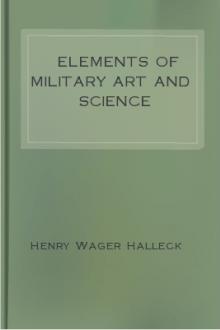Elements of Military Art and Science by Henry Wager Halleck (books you have to read txt) 📕

- Author: Henry Wager Halleck
- Performer: -
Book online «Elements of Military Art and Science by Henry Wager Halleck (books you have to read txt) 📕». Author Henry Wager Halleck
2d. If the formation of a line of battalions in columns of attack be employed, the depth and mobility will depend upon the organization or habitual formation of this arm.
In our service a battalion is supposed to be composed of ten companies, each formed in three ranks. The two flank companies are designed for tirailleurs. This would give a column of four divisions, and consequently twelve files deep; and as only two of these files could employ their fire, there would be much too large a portion of non-combatants exposed to the enemy's artillery. In practice, however, we employ the two-rank formation, which, if the flank companies be detached, would give a column of attack eight files in depth, which is not objectionable. If however, the flank companies should be present in the battalion, the depth of the column would still be ten files.
In the French service, each battalion is composed of four divisions, formed in either two or three ranks. The two-rank formation is the one habitually employed. If all the companies be present, and the formation in three ranks, the depth of column will be twelve files; if in two ranks the depth will be eight, files. If the flank companies be detached, the depth of column will be, for three ranks nine files, and for two ranks six files. (Figs. 27 and 28.)
In the Russian service each, battalion has four divisions of three ranks each. But the third rank is employed as tirailleurs, which gives a depth of column of eight files. The employment of the third rank for tirailleurs is deemed objectionable on account of the difficulty of rallying them on the column. For this reason, the best authorities prefer detaching an entire division of two companies.
The formation of squares is exceedingly effective in an open country, and against an enemy who is superior in cavalry. Formerly very large squares were employed, but they are now formed either by regiment or by battalion. The former are deemed best for the defensive, and the latter for offensive movements. The manner of arranging these is shown in Figure 29.
3d. The mixed system, or the combination of the two preceding, has sometimes been employed with success. Napoleon used this formation at Tagliamento, and the Russians at Eylau. Each regiment was composed of three battalions, the first being deployed in line, and the other two formed in columns of attack by division in rear of the two extremities, as shown in Fig. 30. It may in some cases be better to place the second and third battalions in line with the first, and on the two extremities of this battalion, in order to prolong the line of fire. The centre of the line of each regiment would be less strong, however, than when the two battalions by column are placed in rear of the other which is deployed. This mixed system of formation has many advocates, and in certain situations may be employed with great advantage.
4th. The deep order of heavy columns of several battalions is objectionable as an habitual formation for battle, inasmuch as it exposes large masses of men to the ravages of artillery, and diminishes the mobility and impulsion of an attack without adding greatly to its force. Macdonald led a column of this kind at the battle of Wagram with complete success, although he experienced enormous losses. But Ney's heavy columns of attack at Waterloo failed of success, and suffered terribly from the concentric fire of the enemy's batteries.
Whenever deep columns are employed, Jomini recommends that the grand-division of twelve battalions should have one battalion on each flank, (Fig. 31,) marching by files, in order to protect its flanks from the enemy's attacks. Without this defence a column of twelve battalions deep becomes an inert mass, greatly exposed to be thrown into disorder or broken, as was the column of Fontenoy, and the Macedonian phalanx by Paulus Emillus. A grand-division is sometimes arranged in two columns by brigade, as is represented in Figure 32. These are less heavy than a single column of grand-division by battalion, but are subject to nearly the same objections.
All offensive operations on the field of battle require mobility, solidity, and impulsion; while, on the other hand, all defensive operations should combine solidity with the greatest possible amount of fire.
Troops in motion can make but little use of their fire-arms, whatever may be their formation. If in very large masses, they move slower and are more exposed; but the moral effect of these large moveable columns is such, that they frequently carry positions without ever employing their fire. The French columns usually succeeded against the Austrian and Prussian infantry, but the English infantry could not so easily be driven from their ground; hey also employed their fire to greater advantage, as was shown at Talavera, Busaco, Fuente de Honore, Albuera and Waterloo. The smaller columns and the mixed formation were always most successful against such troops.
From these remarks we must conclude—1st. That the very thin as well as the very deep formation is objectionable under ordinary circumstances, and can seldom be employed with safety.
2d. That the attack by battalions in columns by division is the best for carrying a position; the column should, however, be diminished in depth as much as possible, in order both to increase its own fire and to diminish its exposure to the fire of the enemy; moreover, it should be well covered by tirailleurs and supported by cavalry.
3d. That the mixed formation of the first line deployed and the second in columns of battalion by division is the best for defence.
4th. That either of the last two may be employed in the offensive or defensive, according to the nature of the ground, the character of the general, and the character and position of the troops. Squares are always good against cavalry.
Troops should be habituated to all these formations, and accustomed to pass rapidly from one to another in the daytime or at night. None, however, but disciplined troops can do this: hence the great superiority of regulars on the field of battle, where skilful manœuvres frequently effect more than the most undaunted courage.
The arm next in importance on the battle-field is cavalry. The principal merit of this arm consists in its velocity and mobility. Cavalry has little solidity, and cannot of itself defend any position against infantry; but in connection with the other arms, it is indispensable for beginning a battle, for completing a victory, and for reaping its full advantage by pursuing and destroying the beaten foe.
There are four different modes of forming cavalry, the same as for infantry: 1st in deployed lines; 2d, a line of regiments in column of attack on the centre; 3d, the mixed formation; and 4th, the deep formation of several columns.
1st. The thin formation was deemed objectionable for infantry, on account of its liability to be penetrated by cavalry. The same objection does not hold so forcibly with respect to this latter arm; but full lines are deemed less advantageous than lines deployed checker-wise or in echelon. In either case the distance between the lines should be sufficient to prevent the second line from coming in contact with the first, in case the latter receives a slight check. This distance need not be so great in lines deployed checker-wise, as when they are full, or in echelon.
2d. The second system of formation, that is, a line of columns of attack on the central division for infantry, is by battalion, but for cavalry, by regiment. If the regiment is composed of eight squadrons, the column will contain four lines, two squadrons forming a division; but if composed of only six squadrons, the column will contain only three lines, and consequently will be six files in depth. In either case the distance between the lines should be that of a demi-squadron, when the troops are drawn up in battle array; but when charging, the divisions may close to a less distance.
3d. In forming a grand division of two brigades, by the third or mixed system, two regiments may be deployed in the first line, and three formed in columns of attack in rear of the flanks and centre, as is shown in Fig. 33, the sixth being held in reserve. This formation is deemed a good one.
4th. The fourth system, of deep columns of cavalry, is entirely unsuited for the charge, and this formation can only be employed for troops drawn up in reserve.
The flanks of lines or columns of cavalry are always much exposed, and squadrons should therefore be formed in echelon on the right and left, and a little in rear of the main body, in order to protect the flanks from the attacks of the enemy's horse. Irregular cavalry is usually employed for this purpose.
In the formation of a grand division in line of battle, care should be taken not to give too great an extent to the command of the generals of brigade. If the formation be in two lines, neither brigade should form an entire line, but each should form a wing of the division, two regiments of the same brigade being placed in rear of each other. This rule is an important one, and should never be neglected.
It may also be laid down as a maxim, in the formation of cavalry on the battle-field, that the first line after the charge, even if most successful, may require reforming in rear of the second line, and that this last should be prepared to act in the front line after the first onset. The success of the battle frequently depends upon the charge of the final reserve of cavalry on the flanks of lines already engaged.
It is on account of this frequent manœuvring of the cavalry on the battle-field, its reforming for repeated charges, that great bodies deployed in full lines are principally objected to. They cannot be handled with the facility and rapidity of columns of regiments by divisions. The attack of Nansouty's cavalry, formed in this way, on the Prussian cavalry, deployed in advance of Chateau-Thierry, in 1814, is a good proof of this.
Cavalry may be brought to a charge—1st, in columns; 2d, in line; and 3d, in route, or at random, (à la déban-dade.) These may also be varied by charging either at a trot or a gallop. All these modes have been employed with success. In a regular charge in line the lance offers great advantages; in the mêlée the sabre is the best weapon; hence some military writers have proposed arming the front rank with lances, and the second with sabres, The pistol and the carabine are useless in the charge, but may sometimes be employed with advantage against convoys, outposts, and light cavalry; to fire the carabine with any effect, the troop must be at a halt. In all charges in line, especially against cavalry, the fast trot is deemed preferable to the gallop, on account of the difficulty of keeping up the alignment when the speed is increased. Lances are utterly useless in a mêée, and in employing troops armed in this way, it is of the greatest importance to keep them in order and in line. In charging with the sabre against artillery the gallop may sometimes be employed, for velocity here may be more important than force.
We will now consider the formation and use of artillery on the field of battle. It may be laid down as a fundamental principle, that the fire of artillery should be directed on that part of the enemy's line which we design to pierce; for this fire will not only weaken this point, but will also aid the attack of the cavalry and infantry when the principal efforts are directed towards the intended point.
In the defence, the artillery is usually distributed throughout the whole line, on ground favorable for its fire; but the reserve should be





Comments (0)